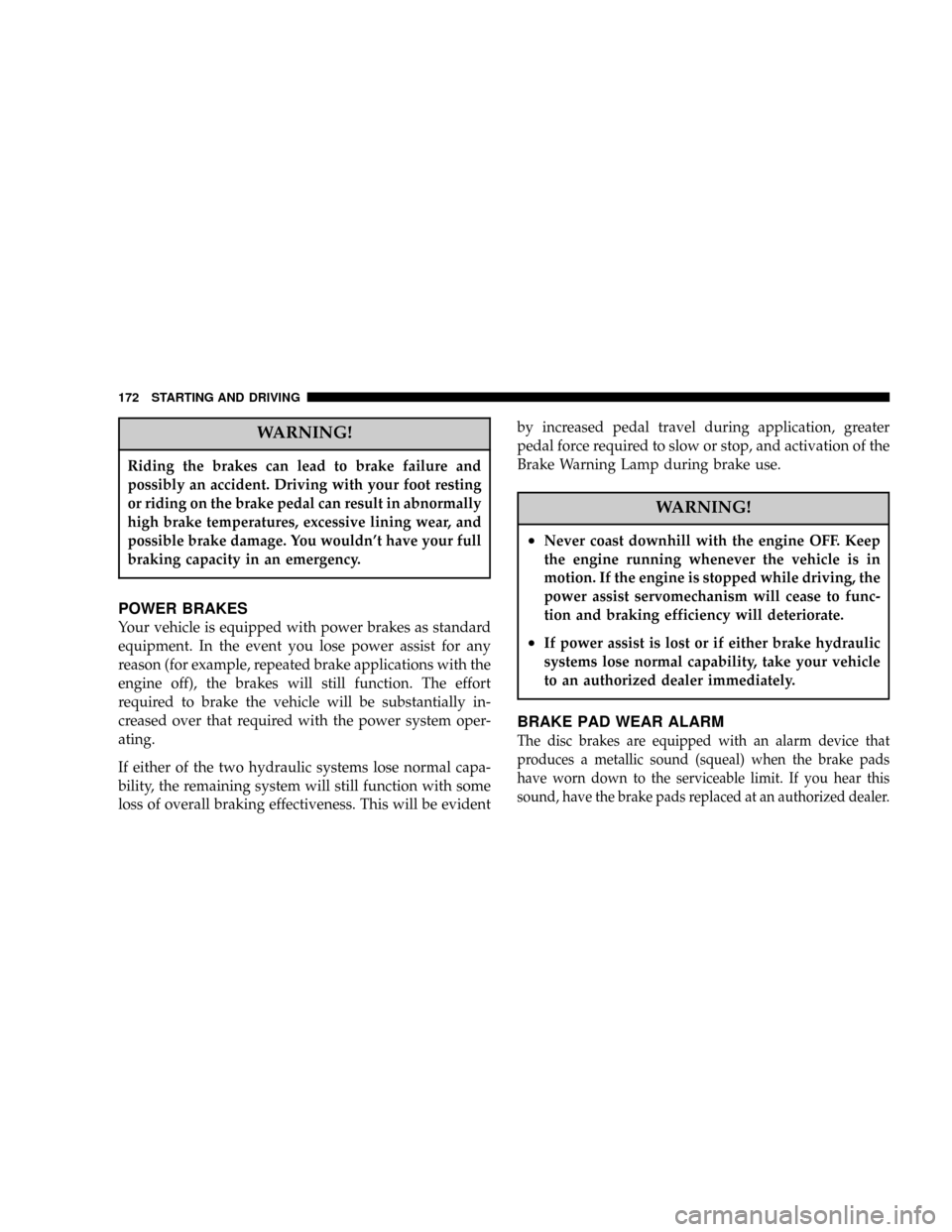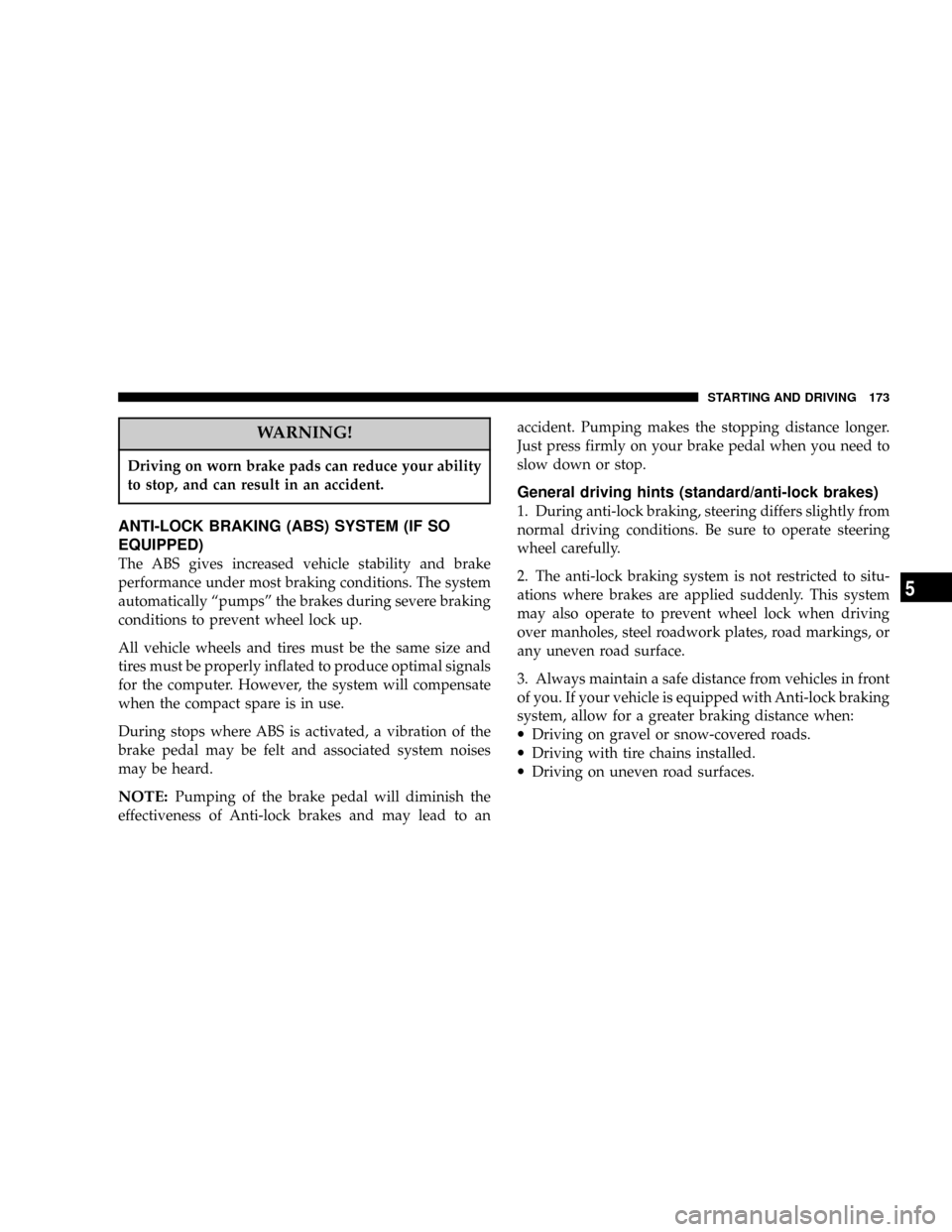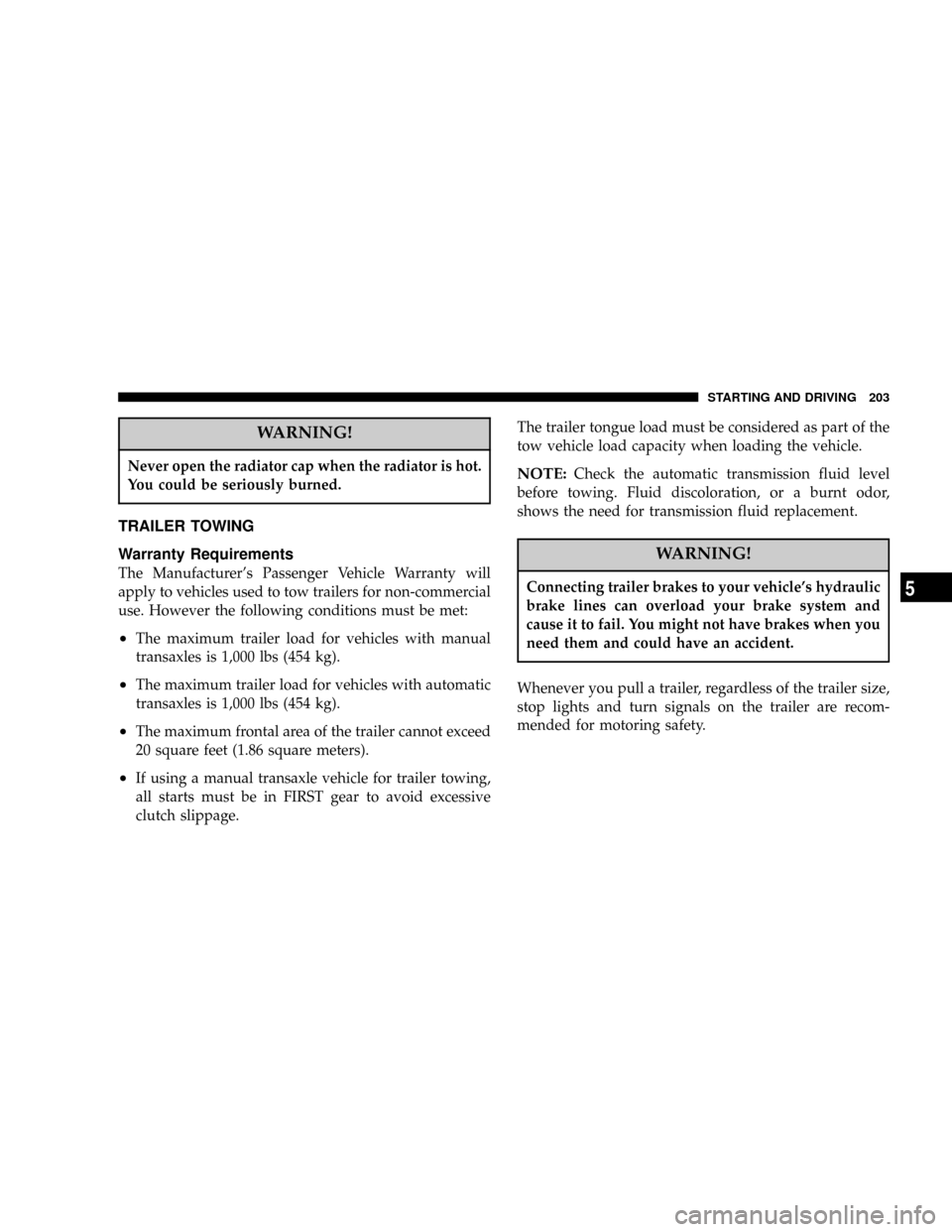brakes DODGE STRATUS COUPE 2004 2.G Owners Manual
[x] Cancel search | Manufacturer: DODGE, Model Year: 2004, Model line: STRATUS COUPE, Model: DODGE STRATUS COUPE 2004 2.GPages: 388, PDF Size: 2.28 MB
Page 18 of 388

If this problem occurs¼
Problem Do this Ref. page
The vehicle is stuck in sand, mud, or
snow.1. Carefully rock the vehicle by shifting the transmission
from low to reverse.
WARNING
1.When attempting to rock your vehicle out of a stuck
position, be sure that no one is near the vehicle. The
rocking motion may cause the vehicle to suddenly lurch
forward or backward, and injure bystanders.
2.Avoid racing the engine or spinning the wheels.
Prolonged efforts to free a stuck vehicle may result in
overheating and transaxle failure.
If the vehicle remains stuck after several rocking
attempts, have a towing service pull the vehicle out.P. 261
The brakes are not functioning
properly after crossing a puddle or
stream.Dry out the brakes by driving slowly while lightly
depressing the brake pedal.Ð
18 INTRODUCTION
Page 142 of 388

NGear positions........................156
NDriving speed
(Vehicles with automatic transaxle).........157
NHolding on an upgrade.................157
NTransaxle reset mode...................158
mAutomatic transaxle Autostick
(if so equipped)
........................158
NSelector lever operation.................159
NIndicator lights.......................161
NSelector positions (Main gate).............162
NSelector positions Manual gate Autostick.....163
NHolding on an upgrade.................165
NTransaxle reset mode...................166
mManual transaxle (if so equipped)..........166
NTo start.............................167
NProper shift points.....................167NRecommended downshifting speed.........169
NDriving precautions....................169
mParking brake.........................169
mBrake pedal...........................171
mPower brakes.........................172
mBrake pad wear alarm...................172
mAnti-lock braking (ABS) system
(if so equipped)
........................173
NGeneral driving hints
(standard/anti-lock brakes)...............173
mSteering wheel tilt lock lever..............175
mPower steering........................176
mInside Day/Night rearview mirrors.........177
NElectrochromic inside rearview mirror
(if so equipped.......................178
NElectrochromic mirror operation
(if so equipped).......................179
142 STARTING AND DRIVING
Page 144 of 388

BREAK-IN RECOMMENDATIONS
Advanced automobile manufacturing techniques permit
you to operate your new vehicle without experiencing a
long break-in period of low-speed driving.
However, you can add to the future performance and
economy of your vehicle by observing the following
precautions during the first 300 miles (500 km).
It is recommended that you drive your vehicle at mod-
erate speeds during the break-in period.
1. Avoid racing the engine.
2. Avoid harsh driving such as fast starts, sudden accel-
eration, prolonged high-speed driving and abrupt appli-
cation of the brakes. These operations not only have a
detrimental effect on the engine but also cause increased
fuel and oil consumption, which could result in malfunc-
tion of engine components. Be particularly careful to
avoid wide-open throttle acceleration in low gear.
3. Do not overload the vehicle. Observe the seating
capacity. (See ªWeightsº page 365)
4. Do not use this vehicle for trailer towing during the
break-in period.
FUEL SELECTION
Your vehicle is designed to use unleaded gasoline only. It
is equipped with a fuel filler tube especially designed to
accept only the smaller diameter unleaded gasoline dis-
pensing nozzle.
WARNING!
Gasoline is highly flammable and explosive. You can
be burned or seriously injured when handling it.
When refueling this vehicle, always turn the engine
off and keep flames, sparks, and smoking materials
away. Always handle fuel in well-ventilated outdoor
areas.
144 STARTING AND DRIVING
Page 153 of 388

NOTE: Slight noises may be heard on engine start-up.
These noises will disappear as you continue warming up
the engine.
Flooded engine
If the engine has become flooded during starting, first
operate the starter for 5 to 6 seconds while fully depress-
ing the accelerator pedal (clear flood), then start the
engine without depressing the accelerator pedal at all.
At extremely cold ambient temperature
If the engine won't start, depress the accelerator pedal
about halfway while cranking the engine. Once the
engine starts, release the accelerator pedal.
CAUTION!
When starting the engine, make sure that you step on
the brake pedal. During very cold weather, when
you start the engine while putting your foot on the
accelerator pedal, move your foot to the brake pedal
immediately after the engine has started.
AUTOMATIC TRANSAXLE (IF SO EQUIPPED)
The automatic transaxle is designed for optimum control
and equipped with adaptive control capabilities. The
electronically controlled transaxle optimally matches
gear shifts to almost all driving and road conditions.
DRIVING UPHILL
The transaxle may not upshift to a higher gear if the
computer determines the current speed cannot be main-
tained once a higher gear is engaged.
For smoother vehicle performance, if you release the
throttle while climbing a steep grade, the transaxle may
not upshift. This is normal, as the computer is controlling
the shifting. After reaching the top of the hill, normal gear
shift function will resume.
DRIVING DOWNHILL
When traveling down steep grades and depressing the
brake pedal, the computer may automatically select a
lower gear. This function assists engine braking efforts,
reducing the need to use the brakes.
STARTING AND DRIVING 153
5
Page 158 of 388

Transaxle Reset Mode
The transaxle is monitored for abnormal conditions. If a
condition is detected that could cause damage, the trans-
axle automatically shifts into second gear. The transaxle
remains in second gear despite the forward gear selected.
Park (P), Reverse (R), and Neutral (N) will continue to
operate. This Reset feature allows the vehicle to be driven
to a dealer for service without damaging the transaxle.
If the problem has been momentary, the transaxle can be
reset to regain all forward gears.
²Stop the vehicle and shift into PARK (P).
²Turn the key to OFF then start the engine.
²Shift into ªDº and resume driving.
NOTE:Even if the transaxle can be reset, we recom-
mend that you visit a dealer at your earliest possible
convenience. Your dealer has diagnostic equipment to
determine if the problem could recur.
If the transaxle cannot be reset, dealer service is required.
AUTOMATIC TRANSAXLE AUTOSTICK
(IF SO EQUIPPED)
Designed for optimum control and equipped with adap-
tive control capabilities, the electronically controlled
transaxle optimally matches gear shifts to almost all
driving and road conditions.
DRIVING UPHILL
The transaxle may not upshift to a higher gear if the
computer determines the current speed cannot be main-
tained once a higher gear is engaged.
For smoother vehicle performance, if you release the
throttle while climbing a steep grade, the transaxle may
not upshift. This is normal, as the computer is controlling
the shifting. After reaching the top of the hill, normal gear
shift function will resume.
DRIVING DOWNHILL
When traveling down steep grades and depressing the
brake pedal, the computer may automatically select a
lower gear. This function assists engine braking efforts,
reducing the need to use the brakes.
158 STARTING AND DRIVING
Page 172 of 388

WARNING!
Riding the brakes can lead to brake failure and
possibly an accident. Driving with your foot resting
or riding on the brake pedal can result in abnormally
high brake temperatures, excessive lining wear, and
possible brake damage. You wouldn't have your full
braking capacity in an emergency.
POWER BRAKES
Your vehicle is equipped with power brakes as standard
equipment. In the event you lose power assist for any
reason (for example, repeated brake applications with the
engine off), the brakes will still function. The effort
required to brake the vehicle will be substantially in-
creased over that required with the power system oper-
ating.
If either of the two hydraulic systems lose normal capa-
bility, the remaining system will still function with some
loss of overall braking effectiveness. This will be evidentby increased pedal travel during application, greater
pedal force required to slow or stop, and activation of the
Brake Warning Lamp during brake use.
WARNING!
²Never coast downhill with the engine OFF. Keep
the engine running whenever the vehicle is in
motion. If the engine is stopped while driving, the
power assist servomechanism will cease to func-
tion and braking efficiency will deteriorate.
²If power assist is lost or if either brake hydraulic
systems lose normal capability, take your vehicle
to an authorized dealer immediately.
BRAKE PAD WEAR ALARM
The disc brakes are equipped with an alarm device that
produces a metallic sound (squeal) when the brake pads
have worn down to the serviceable limit. If you hear this
sound, have the brake pads replaced at an authorized dealer.
172 STARTING AND DRIVING
Page 173 of 388

WARNING!
Driving on worn brake pads can reduce your ability
to stop, and can result in an accident.
ANTI-LOCK BRAKING (ABS) SYSTEM (IF SO
EQUIPPED)
The ABS gives increased vehicle stability and brake
performance under most braking conditions. The system
automatically ªpumpsº the brakes during severe braking
conditions to prevent wheel lock up.
All vehicle wheels and tires must be the same size and
tires must be properly inflated to produce optimal signals
for the computer. However, the system will compensate
when the compact spare is in use.
During stops where ABS is activated, a vibration of the
brake pedal may be felt and associated system noises
may be heard.
NOTE:Pumping of the brake pedal will diminish the
effectiveness of Anti-lock brakes and may lead to anaccident. Pumping makes the stopping distance longer.
Just press firmly on your brake pedal when you need to
slow down or stop.
General driving hints (standard/anti-lock brakes)
1. During anti-lock braking, steering differs slightly from
normal driving conditions. Be sure to operate steering
wheel carefully.
2. The anti-lock braking system is not restricted to situ-
ations where brakes are applied suddenly. This system
may also operate to prevent wheel lock when driving
over manholes, steel roadwork plates, road markings, or
any uneven road surface.
3. Always maintain a safe distance from vehicles in front
of you. If your vehicle is equipped with Anti-lock braking
system, allow for a greater braking distance when:
·Driving on gravel or snow-covered roads.
·Driving with tire chains installed.
·Driving on uneven road surfaces.
STARTING AND DRIVING 173
5
Page 196 of 388

procedure:
(1) The ignition key is turned OFF.
(2) The main switch is turned OFF.
TRACTION CONTROL (IF SO EQUIPPED)
On slippery surfaces, traction control system prevents the
drive wheels (front wheels) from excessive spinning,
during starting or while accelerating in turns on slippery
roads.
NOTE
²
The traction control system functions at speeds
below about 25mph (40km/h).
²Some vibration will be felt in the vehicle body and a
whining sound of a motor will be heard from the
engine compartment when the traction control sys-
tem functions. This is a normal result of the traction
control system operation, and does not indicate a
malfunction.
Driving hints
1. Traction control system does not actively apply brakes.
Always decelerate the vehicle sufficiently before entering
corners or bends.
2. On snowy or icy roads, drive slowly using tire chains
or snow tires.
3. Never mix or use tires of different size since the
traction control system could function incorrectly and
make safe driving difficult.
196 STARTING AND DRIVING
Page 199 of 388

8. Stop driving the vehicle if you think the performance
is noticeably less, or that there is unnecessary engine
miss, or any other engine trouble, such as with the
ignition, etc. If it is impractical to stop driving immedi-
ately, reduce the speed and drive for only a short time.
Have an inspection made by an authorized dealer as
soon as possible.
9. In an unusual event of a severe engine malfunction, a
scorching odor may indicate severe and abnormal cata-
lytic converter overheating. If this occurs, the vehicle
should be stopped in a safe place, the engine shut off and
the vehicle allowed to cool. Once the engine is cool, the
vehicle should immediately be taken to a dealer for
service.
VEHICLE PREPARATION BEFORE DRIVING
Before starting on a trip, perform the following checks to
obtain the greatest possible enjoyment and safety from
your vehicle:
Seat belts and seats
1. Before starting the vehicle, make certain that you and
all your passengers are seated and properly wearing the
seat belts (with children in the rear seat, in appropriate
restraints), and that all doors are locked.
2.
Adjust the driver's seat as far back as possible, while still
maintaining good visibility, and good control of the steering
wheel, brakes, accelerator, and controls. Examine the instru-
ment panel indicators for any possible malfunction.
3. Have the front passenger adjust their seat as far
rearward as possible.
Defrosters
Check operation by selecting the defroster mode and set
the blower switch for high speed operation. You should
be able to feel the air directed against the windshield.
(See ªHeater /Air conditioningº page 234.)
Tires
Examine all tires for excessive tread wear or uneven wear
patterns. Check for stones, nails, glass, or other objects
lodged in the tread. Inspect for tread cuts or sidewall
cracks.
STARTING AND DRIVING 199
5
Page 203 of 388

WARNING!
Never open the radiator cap when the radiator is hot.
You could be seriously burned.
TRAILER TOWING
Warranty Requirements
The Manufacturer's Passenger Vehicle Warranty will
apply to vehicles used to tow trailers for non-commercial
use. However the following conditions must be met:
²The maximum trailer load for vehicles with manual
transaxles is 1,000 lbs (454 kg).
²The maximum trailer load for vehicles with automatic
transaxles is 1,000 lbs (454 kg).
²The maximum frontal area of the trailer cannot exceed
20 square feet (1.86 square meters).
²If using a manual transaxle vehicle for trailer towing,
all starts must be in FIRST gear to avoid excessive
clutch slippage.The trailer tongue load must be considered as part of the
tow vehicle load capacity when loading the vehicle.
NOTE:Check the automatic transmission fluid level
before towing. Fluid discoloration, or a burnt odor,
shows the need for transmission fluid replacement.
WARNING!
Connecting trailer brakes to your vehicle's hydraulic
brake lines can overload your brake system and
cause it to fail. You might not have brakes when you
need them and could have an accident.
Whenever you pull a trailer, regardless of the trailer size,
stop lights and turn signals on the trailer are recom-
mended for motoring safety.
STARTING AND DRIVING 203
5